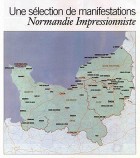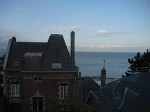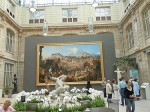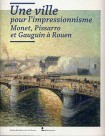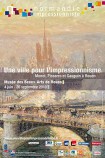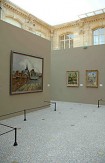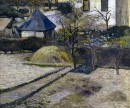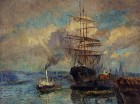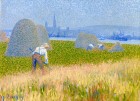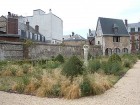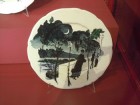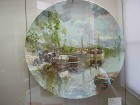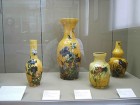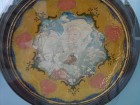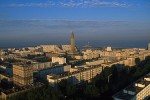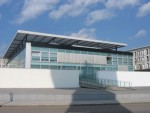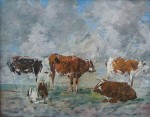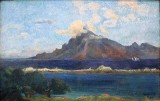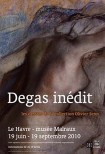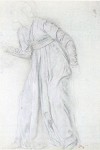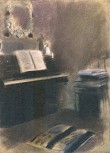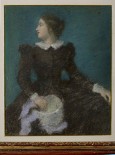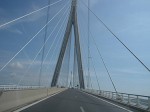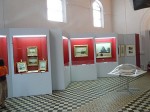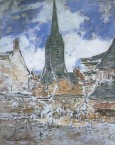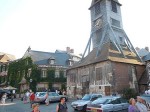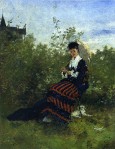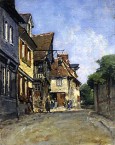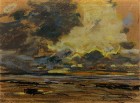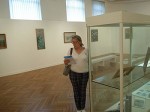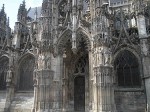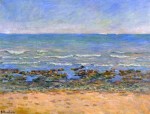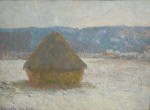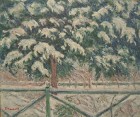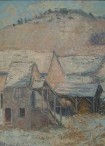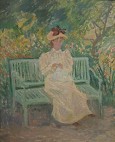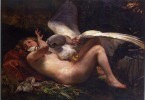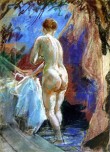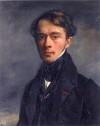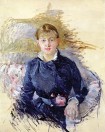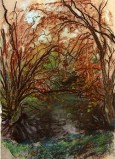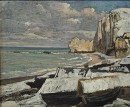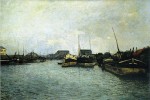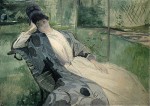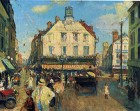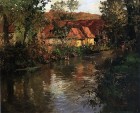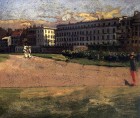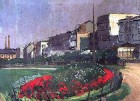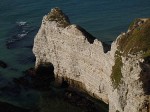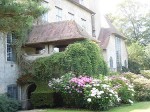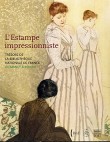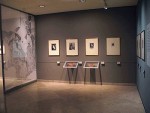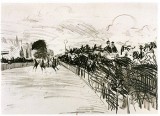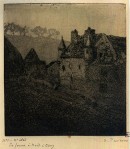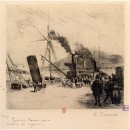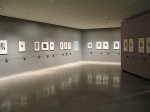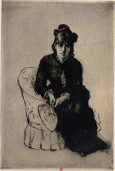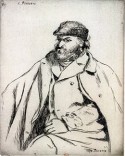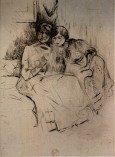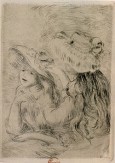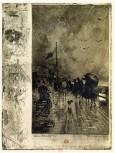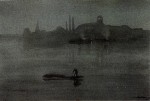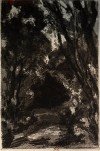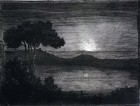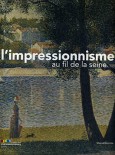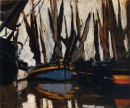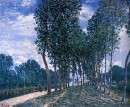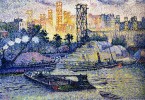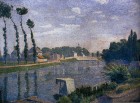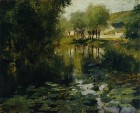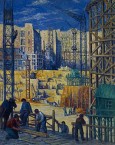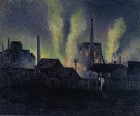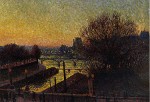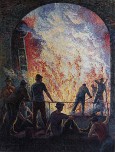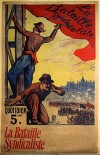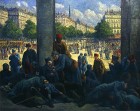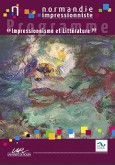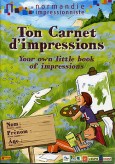The browser will either open the file, download it, or display a dialog.
Normandie impressionniste: An Art-Historical Travelogue
by James Rubin
The major artistic event in France this summer was not an exhibition at the Louvre or the Musée d’Orsay, but an unprecedented series of some 250 arts projects and the participation of approximately 100 local authorities under the rubric of Normandie impressionniste (fig. 1). Thanks to the vision and political clout of former French premier Laurent Fabius, who is now president of the Normandy region, this coordinated group of exhibitions and related activities eclipsed Parisian summer offerings in the mind of the French and much of the international public. The son of a Paris antique dealer, Fabius has a keen and long-standing artistic sensibility. Joining him in assembling both corporate (5 million Euros) and public funding have been movers and shakers like the prestigious collector and associate of the late Yves Saint-Laurent, Pierre Bergé; Jérôme Clément—the thinking man's TV producer, who is retiring as the head of the French-German cultural channel Arté; and Jacques-Sylvain Klein, economist, legislative advisor, art-historian and ultra-persuasive administrator par excellence. Taking seriously the political project of decentralization still alive in the Sarkozy regime after its origination in the 1980s under President François Mitterand, provincial museums are waking up to compete with new national museums, such as the Centre Pompidou at Metz and the planned Louvre subsidiary at Lens, which are drawing, or will draw, huge numbers of visitors from within France as well as from Central Europe, since the latter are located near Germany.
During most of our tour of the exhibitions of the festival, my wife Liliane and I stayed at a friend's house in the still posh Le Havre suburb of Sainte-Adresse. Our view of the harbor was much like that of Monet's aunt Sophie Lecadre, from the window of whose villa Monet supposedly painted The Terrace at Sainte-Adresse (fig. 2). While dining in two different local restaurants on two different nights in Le Havre, we met two very different French couples who were following an itinerary similar to ours. Obviously, the Normandie impressionniste festival had its economic as well as cultural benefits.
P.S. This travelogue written in the present tense reflects the immediacy of our experiences.
Rouen: A City for Impressionism
The biggest success of the festival, with filled bookings encouraged by special excursion train fares, is the exhibition A City for Impressionism: Monet, Pissarro, and Gauguin in Rouen (the title of the English language version of the catalogue) organized by Director Laurent Salomé and his team at the Musée des Beaux Arts de Rouen. The museum is a large Beaux-Arts style building with impressive entry halls and a magnificent atrium through which one enters the exhibition and which the visitor must cross a second time in order to get from the first half of the exhibition to the rest. Before encountering Monet's cathedrals and Pissarro's late city views, it was refreshing to have an espresso next to the bubbling erotic fountain Le Poète et la sirène, made in seductive marble by Emmanuel Hannaux (1903) (fig. 3) and two monumental paintings of belle-époque socialization, Un vendredi au Salon des Artistes Français by Jules-Alexandre Grün (1911) (fig. 4) and Un repas de noces à Yport by Albert Fourié (1886).
The museum faces a lovely little park in the center of town on what is now called the Place Marcel Duchamp. Rouen has long been an art center, with artists passing through it on their way up and down the Seine, coming from Great Britain to the continent or from Paris on the way to the Normandy coast. Artists and tourists alike have been attracted to the cathedral's spectacular late flamboyant gothic style and Rouen's many other medieval monuments. The museum's collection is rich in nineteenth-century art, and is especially known for works by its native son, Théodore Géricault. It also happens to have France's strongest collection of Impressionist paintings outside of Paris. And yet Rouen mistakenly acquired a reputation for reactionary artistic attitudes because of the long-standing belief that in 1903 the city fathers refused the gift of the extraordinary collection assembled by the local textile heir François Depeaux, presumably because the works it contained were too progressive. Thanks to the research of François Lespinasse, published in the catalogue, this myth has now been completely put to rest. The documents and correspondence he unearthed reveal that the collection simply could not be accepted in 1903, because it became embroiled in Depeaux's divorce proceedings and was put up for sale. Not until 1906 could the city receive what Depeaux managed to salvage through repurchase from what had been a collection of some 700 works.
For full disclosure, note that I contributed an essay entitled "Rouen's Industrial Sublime" to the important and weighty tome that accompanies the show (fig. 5). So did Richard Brettell on Gauguin in Rouen; Jeanne-Marie David, who publishes important archival discoveries regarding the role of Monet's brother Léon in the Rouennais industrial bourgeoisie; Claire Durand-Ruel Snollaerts, co-author of the Pissarro catalogue raisonné who follows his tracks in Rouen; and Claire Maingon on Rouennais Neo-Impressionism. Full credit for the exhibition itself, however, goes to the team of curators and researchers whom the able, energetic, and amiable Director Salomé assembled and worked with in harmonious collaboration.
In many ways, the exhibition is a revelation, not only for the presentation of works by many lesser known painters, but for what it reveals about its three stars, Monet, Pissarro and Gauguin. Few have closely studied Monet's first Rouen campaign, when in 1872 he stayed with Léon, who ran a chemical dye factory in Déville-lès-Rouen. The location explains Monet's discovery of the industrial Cailly river valley where he made the unprecedented industrial landscape The Cargo Convoy (The Pola Museum, Japan). Unfortunately, it could not be borrowed. Monet's main focus, however, was a series of port scenes that require comparison with his group of paintings of the port of Le Havre, the latter including the famous Impression: Sunrise, but also a majority of more overtly industrial harbor views. Unlike Le Havre, Rouen's harbor was temporarily in structural decline—accumulated silt prevented the biggest ships from docking—and was suffering from competition with the railroad. Monet's pictures bear witness to more traditional forms of activity than at Le Havre. Pissarro's first visit to Rouen, in 1883, is probably even less well known than Monet's. Like Monet, he painted mainly river activity, the port and the bridges, and yet his urban and industrial views focus more clearly on factories and laborers. Their execution in a pasty, pre-pointillist technique helps one understand his important role in the development of Neo-Impressionism.
When Monet returned to Rouen for his second and more famous extended campaign, he stayed in a hotel across from the cathedral. The nine paintings chosen for the exhibition from his famous Cathedral series can be considered to work in pairs, for example, an ébauche in grays and blues next to a finished version of the same view in a similar palette, browns added, or two different examples of setting sunlight on the facade, one more orange, the other mainly pink (fig. 6). Another pair is done with far darker tonalities. An example from Belgrade hangs near its cousin from Los Angeles. Incidentally, only the latter, from the Getty Museum, could be fully appreciated for its built-up, tactile, heavily worked surface, all the others having been put under glass by the various lenders which included the Musée d’Orsay, the Museum of Fine Arts, Boston, and the Musée Marmottan. Accompanying the cathedrals in the same gallery was Monet's large, extraordinary atmospheric sketch of the city from a distant hill, which belongs to the Rouen Museum's own collection. Along with a late Pissarro, it became part of the exhibition poster (fig. 7).
When Pissarro revisited Rouen during the 1890s, his work could not have been more different from Monet's cathedrals. The views are even more deliberately industrial than in 1883, with pictures of cranes unloading cargo along the riverbanks, usually with either the modern cast-iron Boieldieu bridge in the background or the smoking factory chimneys of the Saint-Sever neighborhood on Rouen's left bank (fig. 8). Pissarro's chalky, matte surfaces take his earlier stylistic developments much further, with a structural and compositional solidity that gives his paintings a rigor and toughness appropriate to the forms and activities he was representing, but without appearing as mechanical as the Neo-Impressionism he had earlier rejected. Although his views are closely related to one another, as in other successful series paintings like those of Monet, each has its own power. Moreover, their relationship is different; together, certain groups form a panorama rather than repeating near-identical views. There is nothing like two galleries filled with sixteen of these related views to prove the point that not a single one of them becomes tiresome.
The exhibition also has two views of the city center with its churches by Pissarro, alongside which are hung a plethora of similar views by local painters in the Impressionist circle, such as Eugène Boudin, Gustave Loiseau, Léon-Jules Lemaître, Robert-Antoine Pinchon, and Pierre Dumont. Each has its charms, but only two artists—both foreigners—Emile-Othon Friesz and the American Frank Boggs, whose rooftop view was one of the largest pictures in the exhibition, could stand up to the Pissarros for sustained power and interest (fig. 9).
One of the most interesting chapters in the exhibition is a group of six pictures by Paul Gauguin, who came to Rouen in November 1883 after hearing that Pissarro was there. Unlike Pissarro, who was staying in Eugène Murer's hotel overlooking the port from Place de la République, Gauguin took lodgings in the Quartier Jouvenet, on the city's northern hillside, in those days far from the center of town. These fascinating and often beautiful works reveal Gauguin painting in subtly varying styles ranging from a rather conventionally impressionist view up a road and a river scene, the latter having the advantage of a large fishing boat provocatively unbalancing the composition to the left, to a couple of landscapes that lie stylistically somewhere between Pissarro, Cézanne, and Guillaumin. Their colorist complexity is barely noticeable in reproduction. A Corner of the Garden from the Portland Art Museum is executed in tones that are both lush and cool (fig. 10). Richard Brettell's catalogue essay charts Gauguin's sojourn, during which he also made still-lifes and some portraits that include the touching image of his sleeping son Clovis. But nothing can equal the viewing of pictures themselves to reveal the sustained quality of a gifted master, even before he has fully worked out his definitive style.
Among other revelations of this superb and novel exhibition are some very talented Rouennais painters. Not the least of them is Albert Lebourg, a charming if not terribly original painter long appreciated by local collectors, whose style lies somewhere between mainstream Impressionism and that of Eugène Boudin (fig. 11). A group familiarly called "Les Mousquetaires," is said to have been at the origins of the Ecole de Rouen, which included the Neo-Impressionist Charles Frechon, as well as others in passing, such as Charles Angrand and Auguste Dubois-Pillet. Frechon's light tonalities, relaxed pointillism, and simple compositional geometries remind one of Seurat's earlier landscape paintings and studies, before he launched into full-fledged figural compositions (fig. 12). An exhibition of drawings by Angrand in the museum's graphics galleries complements the paintings shown in this exhibition. It is accompanied by a book as well. By contrast, Joseph Delattre's pictures show a greater will to geometric structure with scenes along the urban riverbank (fig. 13). Delattre, who grew up in Déville, knew Léon Monet and his collection of Impressionist paintings. In spite of his compositional rigor, the charm of his execution is related to his emulation of a more or less mainstream Impressionist technique.
The food for thought, reassessments and filling in the blanks offered by the Rouen exhibition would have been enough to make Normandie impressionniste a supremely successful scholarly endeavor, in addition to its value as an attraction for tourists and art lovers generally. Specialists who visit it will not be disappointed; indeed, they might be stunned, as I was, by the power, beauty, and variety of what I saw. It may be true that in the later galleries featuring views of the city, there is a certain monotony in the work of lesser lights. And yet, if one came upon them earlier in the exhibition, or as a group on their own, without comparison to the Pissarros and the Monets, their charm might be more evident. They must have had great appeal to tourists enjoying the center of Rouen for its celebrated gothic and Norman architecture exemplified by the cathedral, the Church of Saint-Maclou, the Place du Marché and the Gros Horlorge. It is worth noting, however, that the avant-garde artists, Pissarro, Monet, and Gauguin, turned their backs to this aspect of Rouen's central city until, in Monet and Pissarro's case, later in their careers, when they drew forth from such places pictures whose originality was unprecedented, and whose power might make other views seem conventional and trivial. It is the great merit of this exhibition both to enhance the stature of its stars, and at the same time to raise respect for those regional painters who worked not so much in the shadows of their more celebrated contemporaries as in productive independence from them towards personally unique and positive results.
Rouen: Atmospheric Glazes, "Impressionist" Ceramics
Adjacent to the Musée des Beaux-Arts, in a three-story townhouse with a large unkempt garden, and also under the directorship of Laurent Salomé, is the Musée de la Céramique, which features a superb exhibition of so-called Impressionist ceramics (fig. 14). Its title, Emaux atmosphériques, which best translates as "Atmospheric Glazes" is an apt description of the surface decoration of the many traditional plate, pot and vase forms on display. They are covered by radically innovative designs that might be said to reveal the potential for abstraction within Impressionism even better than a concurrent exhibition at the Musée Marmottan-Claude Monet (organized by the Museo Thyssen-Bornemisza in Madrid) called Monet et l'abstraction. Best known among Impressionist ceramic designers is the engraver Félix Bracquemond, a friend of the Impressionists whose etching after J. M. W. Turner's Rain, Steam and Speed appeared at the first Impressionist exhibition, and seemed to link the new style to the experience of Turner's work that painters such as Pissarro and Monet might have had when they were in London during the Franco-Prussian War. However, Bracquemond's early designs are figural—bathers in a river landscape—and not especially atmospheric.
Words are inadequate to describe the glistening surfaces and increasingly arbitrary and abstract designs that a decorative art form allows. There are several examples of decorative flowers so freely sketched on pots that the look is totally modern. Several are pieces that imitate the simplicity of Japanese design, for example, with a flowering branch or a bird, or other vegetal motifs, set off center on an otherwise empty background of lighter color. Bracquemond made several pieces of this sort in his first "Rousseau" set of tableware (1866-1867, Manufacture de Creil et Montereau), so called for its production at the Fabrique Rousseau. In a later, "Second Rousseau" service (c. 1868), he provided designs with Parisian scenes. One plate shows a well-dressed woman alone, looking out over the Seine from what appears to be the Left Bank on a moonlit night, with the Pont Neuf in the background (fig. 15). The piece is called Notre-Dame, which although the cathedral is absent from the image itself, would be somewhere in the distance if I am correct that the background shows the Pont-Neuf. The plate is executed almost exclusively in shades of black on a white background, with a bit of green foliage and two tiny touches of red to signify the flame of two gas lamps that cast their light onto the leaves. A couple, with the woman leading the man, moves furtively off to the right. Our Lady indeed! There must be a joke somewhere. And on a plate dating to the late 1860s!
Several pieces of ceramic decorative sculpture have handles formed like female bathers attached to a vase, or a base decorated with a generalized landscape. Other pieces, such as one decorated by Yéfgheni Morand for Haviland (1876-1881) have poppies in the foreground of a misty Impressionist landscape, perhaps a reference to opium dreams. Another has a tableau of a dance lesson, clearly inspired by Degas. The Bourg-la-Reine manufacture also produced Impressionist scenes, such as a large plate decorated by Auguste Lepère c. 1876-1878 with a scene of barges along the riverbank closely inspired by Alfred Sisley's 1870s pictures of barges on the Canal Saint-Martin, but in brighter, more spring-like colors (fig. 16). Another display of work from the same company consisted of three brilliant yellow vases decorated with large blue flowers that wind around and cover a great deal of the surface (fig. 17). If the shapes of the vases were not so obviously traditional, one might confuse the décor with those produced twenty years later under the inspiration of Art Nouveau.
A final note on this exhibition is its revelation of works by Marie Quiveron, Félix Bracquemond's wife, who gave up a promising career as a figure painter after she married. On display are two large plates, each decorated with a female figure in medieval or allegorical costume (fig. 18). The label for one of them calls the figure a queen, but the crown of flowers she is wearing is not necessarily a royal attribute. Quiveron's original designs for the plates show firm contours in a traditional, academic style. Although in her paintings, she responded to Impressionist color and surface techniques, her figures retained their volume and sharp outline in an effect more comparable to Caillebotte or Renoir of the mid 1880s than to the mainstream Impressionism of the 1870s. In these plates, too, brilliant colors prevail, but the carefully drawn figures are consistent with the style of Quiveron's known figure paintings of the years around 1880.
Le Havre: The Senn Collection and Unpublished Drawings by Degas
The center of Le Havre and its port were utterly flattened by World War II bombing as part of the invasion of Normandy. A large part was re-built by the architect Auguste Perret in a modern style, with modernist uniformity and a grid-like urban geometry that may have been intended as an orderly response to an industrial city that grew haphazardly over the complex terrain of the Seine estuary (fig. 19). Sixty years later, however, the city seems monotonous and gloomy to anyone but architectural historians, and it is a small consolation that Perret's buildings have been listed as a UNESCO World Heritage site. Unlike the wide sands of Deauville, Le Havre's beaches are mainly covered by stones. Le Havre has thus tried to claim leadership in the area of modernity, and indeed since the early twentieth century, its small group of collectors, including Charles-Auguste Marande and Olivier Senn, saw to it that it stayed on the cultural map. The breathtakingly elegant Pont de Normandie (see below) has put the region front and center architecturally once again, but it is outside the city limits. In the city center, other architectural efforts, including a theater that looks more like a small nuclear cooling tower, are more questionable.
The exception, and certainly the city's brightest cultural and architectural spot, is the Musée André Malraux (fig. 20). Named for the résistant, philosophical novelist, and writer of books on art, including the classic, Le Musée imaginaire, it was inaugurated in 1961 by Malraux himself during his term as Charles De Gaulle's minister of culture (1959-1968). It was the first of what are now numerous Maisons de Culture across France, following Malraux's original initiative. Built of glass and steel from 1955-1961 by architects who included two of Perret's students, facing the port near the tall semaphore that signals its entry, the interior was thoroughly renovated in 1999. Since then, it has received the gifts of two major collections strong in nineteenth-century painting and drawing, and it houses works that remained in Eugène Boudin's studio at his death (fig. 21). Its three Monets, three Pissarros, two Renoirs; its Gauguin (fig. 22), and Pont-Aven school pictures, and its Neo-Impressionist holdings would in themselves justify a trip to Le Havre in the context of the Normandie impressionniste festival.
Before planning for the festival began a little over two years prior to its opening—a very short lead time—the Musée Malraux was preparing the second exhibition of its drawings from the collection formed in the early twentieth century by Olivier Senn, most of which are unpublished. The first exhibition focused on approximately 40 drawings by Henri-Edmond Cross. The third will cover what remains, including important works by Delacroix, Guillaumin, and Marquet. The collection was given to the museum in 2004 by the collector's granddaughter, Hélène Senn-Foulds, who five years later complemented it with her father's collection.
Called Degas inédit, the exhibition's focus in spite of its advertisement seems for the most part barely related to Impressionism (fig. 23). Senn's interest in Degas favored the early, more academic work. Directly from Degas's atelier sale, he purchased a horde of pencil and/or chalk studies and preparatory drawings for the early history paintings. Many of them are on unattractive tracing paper, but they certainly will be a treasure-chest for some student of early Degas. Studies in different media for Semiramis Building Babylon, Spartan Girls and Boys, The Daughter of Jephtha, and The Suffering of the City of Orleans abound (fig. 24).
Despite the preponderance of early, sometimes dryly academic works, the exhibition does some justice to Degas's stylistic diversity. An early line drawing showing two female figures leading a pair of horses in medieval regalia looks not only Ingres-esque, but almost Pre-Raphaelite. A chalk study from behind of a woman's braided hair arranged in a circle on top of her head delivers the opposite, densely realist effect. A study in pastel for Mme. Camus at the Piano, absent the figure, hangs beside a squared-off charcoal study for the same painting (fig. 25). Both show exquisite delicacy, whereas some of the studies after the live model have a power, and especially a precision, uncharacteristic of Degas's more generalized and sketch-like chalk and pastel drawings from the 1880s; there is a fine example from this period called La Toilette, done in black and white on brown paper, that was used for the poster (see above). Senn also had the good instinct to purchase one of Degas's rare watercolor landscapes, a mountain view, dating like most of the others of the same genre from 1890-1893. The exhibition ends, finally, with a guessing game. A pastel drawing of an interior once attributed to Degas is presented as a mystery, inviting viewers to consider whether it really is by Degas, or another artist (fig. 26). My guess is that it's a Vuillard, or someone near him, once owned by Degas. If you can identify it, I will happily forward your opinion.
Honfleur: Between Tradition and Modernity, 1820-1900
While crossing the Pont de Normandy from Le Havre is a modernist architectural joy (fig. 27), entering Honfleur in the summer is a nightmare. Signage to the Musée Eugène Boudin in Honfleur is so poor, and the summer traffic is so heavy in what is now one of the Normandy coast's most egregious tourist traps, that one is forced to leave about twice the amount of time one would normally allocate to find the place. When asked about the absence of road signs to the museum, a member of the staff hinted at conflict between the mayor's office and the museum. All I could think of was that, overridden by tourists, many of them from Paris judging by the license plates, Honfleur's politics were following the Parisian model too. That is, disagreements between local and national authorities are mimicked by the lack of cooperation between the national and municipal museums in Paris; a similar lack haunts Honfleur. The successes of Rouen and Le Havre show how well a cooperative model can work. The final blow at Honfleur was that after reaching the museum along a treacherously narrow street, there was neither a single place to park, nor even a sign indicating where parking might be found. Frankly, if the town wants to discourage automobile traffic, it ought simply to reserve its streets for pedestrians and give adequate directions to sites not accessible by car. What they're doing here is discouraging visits to the museum.
Entering the museum from the tourist chaos of the old town, one might expect some relief. However, if the interior of the museum isn't exactly chaotic, it certainly deserves a makeover. Pictures in the large main exhibition hall are hung in permanent display cases built against the walls. I can't recall the date of my last visit to Honfleur, it was so long ago, but I remember it well enough to say nothing has changed since then. Three extraordinary Courbet seascapes from the Musée Boudin, Lons-le-Saunier and Madrid (Thyssen-Bornemsza) are impossible to see close up. Closely related is a seascape of Honfleur by Boudin dated 1866. The best works on display by Boudin, Jongkind and others of the pre-Impressionist generation are similarly installed. I smashed my nose trying to inspect two lovely watercolors dated 1850 by Jongkind from a private collection. They were lying flat on a low round table, and I hadn't realized when bending over that they were protected by a plexiglass bubble (fig. 28).
Also on display, but hanging on the wall and therefore more approachable, is an unfinished picture by Monet showing the strange bell tower facing the church of Sainte-Catherine, propped up by four diagonal beams even in Monet's time (fig. 29). It bears the Monet atelier signature stamped by Monet's son, Michel, who donated it to the Museum in 1964. The church, across from which one can have a pleasant meal at any of several fish restaurants, must be one of the few gothic churches in France made of wood (fig. 30). A lovely small portrait of Madame Sporck by an ostensible disciple of Boudin, Charles Pécrus, was a new discovery for me (fig. 31). So was the painter Alexandre Dubourg, whose street scene in Honfleur, among many other images exhibited, looks much like the neighborhood in which the Museum is located (fig. 32).
The Musée Eugène Boudin (not its original name) was, in fact, founded in 1868 by Dubourg, a local painter who was a friend of Boudin and emulated his work. The collection has important reserves by both artists. Indeed, the present exhibition was made up primarily from the museum's own collection, with some outside loans for good measure. One has the feeling it was slapped together at the last minute in order to be part of the Normandie impressionniste festival. A four-page brochure is available for the general public, but even if there were financial limitations, it makes no sense that two of the pictures are reproduced in the brochure twice. It is well known that French museums work on a much shorter time schedule than their American counterparts, but most of them seem to come up with respectable results.
One can learn a great deal about Dubourg from the catalogue essay by the musuem's director, Anne-Marie Bergeret-Gourbin. Indeed, in contrast to the exhibition, its poor publicity and public signage, the catalogue is a serious and altogether professional publication. It has useful and important essays on the history of Honfleur during the period of "the meetings at Saint-Siméon," by historian Pascal Lallière, and on French marine painting during the nineteenth century by Laurent Manoeuvre. Musée d’Orsay curator Caroline Mathieu writes about Baudelaire's discovery of Boudin's cloud studies during a visit to his mother's house at Honfleur in 1858; a few of them are on display (fig. 33). Dominique Lobstein, also from the Orsay and widely known as an expert on nineteenth-century Salons, has a piece on the fate of Honfleur subjects and artists at the official Salons, and reactions to them in the press.
And so, even if one must rely heavily on the catalogue, there is always something to be discovered. I think that I have never gone to an exhibition without learning something of value, in this case not only a lesson in museum strategy, but also a much firmer sense than I had before of painting on the Normandy coasts, prior to and in the early days of Impressionism. One realizes that the style of painting preferred by Boudin and other Normandy coast painters was not superseded by Impressionism for it continued alongside its newer rival. In that sense, "pre-Impressionism" is a misnomer. Rather, the Normandy Picturesque style, as I would call it, is based more on drawing, or on drawing with paint—as in sketching—than is mainstream Impressionism. The latter shifted direction under the impact of Manet, with a style based more on color dabs and patches and on Japanese compositional design than on colored lines. The word "picturesque" comes to mind for two reasons. First, Normandy views were an outgrowth of eighteenth-century picturesque painting to which unusual topography and subjects of natural and architectural spectacle gave rise. Second, the mode of painting is itself a source of visual pleasure, with its displays of deft brushwork and sketch-like suggestion. It is distinct from Barbizon School painting, which it parallels chronologically, not only in location, but also in its greater luminosity and brighter, more leisure-orientated outlook. Today, of course, the same pleasures are derived from Impressionist painting, but in its day, Impressionism was berated for surfaces and handling that seemed unpleasantly choppy and impastoed. And the Impressionists' commitment to modernity led them to places that did not always include leisure, and usually lacked the nostalgia that so frequently informs the picturesque. On reflection, one might suggest that Monet assimilated enough of the coastal orientation towards leisure and pleasant weather that, despite his stylistic originality, he was the first Impressionist to be widely accepted—with the exception perhaps of Renoir, who always aimed to please and who was driven at least as by much economic necessity as Monet.
Louviers: Blanche Hoschedé-Monet (1865-1947), an Impressionist Destiny
Free-lance curator Philippe Piguet is known for his many exhibitions of contemporary art, including Sélést'art in the town of Séléstat near our summer home in Alsace. It may not be as well known that he is a descendant of the Hoschédé family, a grandson of Blanche Hoschedé, whose mother, Alice, lived with Monet after the death of Monet's first wife. Many years later, Alice married Monet, following the death of her own husband, Ernest, who had been one of Monet's early patrons and through whom they had met. Blanche, the Hoschedé's second child, must have been about eleven years old when she first saw the painter, and she claimed to have been impressed by his work even then. It is said she was the only person to whom Monet ever gave "lessons." She often painted with him, but usually avoided comparison by choosing different motifs or viewpoints. Although the exhibition uses the name Monet combined with Hoschedé, Blanche never signed with her stepfather's name appended to hers during Monet's lifetime. Clearly a woman of conscience, even afterwards, she only did so sporadically. And yet in 1897, she had married Claude's oldest son Jean, meaning that Monet was not just her stepfather's name, but her married name as well. When in 1911 her mother died, and in 1914 Jean succumbed to syphilis contracted years earlier, she tended to the elder Monet and became his primary support when his health began to falter.
The vast majority of Hoschedé's works remain in the hands of Blanche's descendants. Philippe Piguet's special access and persuasiveness have led to an exhibition that will be a real discovery for anyone who ventures to visit (fig. 34). When we visited, the only other people beside ourselves were the exceptionally amiable staff. A dusty town south of Rouen in the summer, Louviers is notable for its church of Notre Dame, which houses an alabaster bathtub, used for conversions in the Middle Ages, and stained glass windows by Marc Chagall. To its nave is appended a glorious monumental portal (fig. 35). Louviers also boasts the Cloister of the Penitents, which is built out over the waters of the Eure River, the only such edifice in France, according to a distinguished white-haired gentleman of the local aristocracy who will perform self-appointed guide services for receptive tourists. (He can be recognized by his refrain, which he repeats as a transition to his next topic—"But, Monsieur, I have already taken far too much of your time with my trivialities.")
The Museum is a small but elegant and well-lit Beaux-Arts edifice behind which is a public garden. It faces an oval roundabout that might have become the center of a more modern town had Louviers developed into what the museum's founders must have hoped. Other than through a few works in the Musée Municipal A.G. Poulain at Vernon, near Giverny, and rare examples scattered elsewhere, from the Los Angeles County Museum to Rouen (on deposit from Orsay), Hoschedé's work is barely known other than as a name, mainly from the memoirs and literature on Monet. This exhibition fleshes out her career as an accomplished and serious artist in a way that the few publicly owned works could not possibly do. The heirs have obviously kept many first rate works for themselves—and why not, since they won't get rich by selling them, unless, thanks to exhibitions like this one, their value increases considerably. For that to happen, however, more visible venues will be necessary. Surely this exhibition, so dominated by works belonging to the family, is therefore a work of love and pride in the artist's accomplishment.
Certain pictures measure up, if not quite to Monet himself, at least to other contemporaries far better represented in museums. The main drawback, historically speaking, is that the work is retardataire. Yet, it is original and fresh enough to escape being labeled as merely derivative, and there are very few instances where one of her pictures could be taken for the work of someone else. Two pictures from public collections are among the most beautiful; Peonies is the painting mentioned earlier from Rouen, and Beach on the Normandy Coast was borrowed from the museum at Vernon (fig. 36). Many of Hoschedé's works, by comparison to these two, have a more limited palette and a drier surface quality. In that sense, these two examples are more slick, more like Monet. Peonies is signed Hoschedé-Monet, and it is dated 1931. One wonders if the beach scene might not be a late work, too. In any case, they are no less beautiful for being so.
The main body of Hoschedé's earlier work has a slightly faded look, and often her matte surfaces make one think of pastel. A few works are dated, and if the catalogue can be trusted for its attributions of several others to certain years, a stylistic development becomes clear. The catalogue is indeed a useful tool, for in addition to reproducing works in the exhibition itself, it contains a list with thumbnail images, when possible, of other works, including ones with unknown locations. On the other hand, however, the reproductions are so dull they may well defeat whatever effort has been made to revive her reputation. In 1881, presumably, Hoschedé did several pictures of grain stacks, distinguishable from Monet's only by their facture, which lacks the level of pleasing skill and assurance to be found in her mentor's series (fig. 37). One wonders to what extent they are copies or pictures done under Monet's tutelage.
During the 1890s and early 1900s, Hoschedé seems to have worked in the thrall of Symbolist generalization, for many of her works are limited in palette and blur the outlines of their forms in ways that make them seem suspended in mist. Of course, Normandy is often subject to drizzle and fog, especially the latter rising off of snow. Among some of Hoschedé's subtlest works are winter scenes, of which the exhibition contains about a half dozen. In one case, the heavy snow accumulated on evergreen branches forms geometric patterns that contrast with the crossed supports of a fence that frames the image in the foreground, somewhat as in Manet's famous The Balcony, but on the horizontal (fig. 38). Another is a coloristically sensitive view of Giverny in the snow. In a small picture of Dubosc Farm, the shapes and outlines softly echo the Synthetist Gauguin (fig. 39). All three pictures belong to members of the Piguet family.
It seems unfair, however, constantly to reference major artists when attempting to define a lesser one. If I find Hoschedé's works worth considering, they must have unique qualities that make them recognizable and give them value on their own. There is a peculiar discretion in the dryness of her painted surfaces, which might be reminiscent of pastel. Of course, Monet made pastels in his early years, and other Impressionists, especially Degas and Renoir, often worked in the medium. Hoschedé reproduces some of their delicacy in oils, not only through her matte finish, but also through high keyed colors that attenuate the bolder contrasts often found in mainline Impressionist pictures. Her canvases often seem heavily worked, with thin colors posed on a thickly built-up base, although never to the extent found in Monet's later paintings. This technique endows her discrete surfaces with a bodily quality that enhances their presence, even while they seem at the same time reserved or effaced. Whether this reserve is a gender issue is impossible to know, but it does seem to reflect Blanche Hoschedé's private and, following the death of her husband, solitary yet determined character. Even her garden scenes in full sun are muted by coloristic restraint, giving them a quiet contemplative feel, as opposed to the celebratory cacophony of so many flowery Impressionist paintings (fig. 40).
Lisieux: Léon Riesener (1808-1878), from Romanticism to Impressionism
Lisieux sits among the rolling hills of prime Normandy farm country. It is the site of one of those grand basilicas high on a hill to which both the devout and the curious still make pilgrimages, all too often neglecting the Church of Saint Peter, Lisieux's former cathedral built in a pure thirteenth-century gothic style. On the other side of town, in an old Norman beam-style row house near the banks of the Touques river (which flows North to the Channel between Deauville and Trouville) is the Musée d'Art et d'Histoire. Its exhibition is devoted to the painter Léon Riesener, whose destiny has been all too marked by his family ties to a celebrated but distant cousin, Eugène Delacroix. Riesener, who had an early interest in photography, made two daguerreotypes of his cousin that are on display, and artistically, Riesener's spectacular oil copy of Delacroix's Lion Hunt bears eloquent testimony to his admiration (fig. 41). Yet Riesener's relationship to Delacroix was as fraught with trepidation as it was filled with awe, just as his reputation has been subject to a related push and pull of both proximity and distance from the great master. Not surprisingly, the exhibition is as fascinating for the comparisons it evokes as for the personality of the artist that emerges.
One of the first things a visitor notices is that the galleries are dark; all the shades are down because pastel was one of Riesener's specialties. Yet for a special exhibition, wouldn't it have been possible to let in enough light to view the many less fragile works? In addition, many pictures, as at Honfleur, are hung inside vertical wall cases. Like the catalogue, which is broken up into more chapters and sub-chapters than I could count, the exhibition is hard to follow. Moreover, the reproductions are small and dark; and anyone who thinks that the CD included with the catalogue contains fine, high-definition images is quickly disillusioned by discovering that it contains, rather, documentation including the family tree, an inventory and other documents.
The vast majority of works in the exhibition were part of the contents of the Château of Saint-Germain de Livet when the widow of Riesener's grandson bequeathed it all to the city of Lisieux. With the exception of this temporary exhibition, one can only see them at the Château. In some sense, the exhibition's organizers may have suffered from too much information. The show's coherence is further complicated by the fact that Riesener tried his hand at many different genres, including landscape, or at least landscape sketches, hence giving rise to the tenuous connection to Impressionism. In spite of these complexities, visitors to the exhibition, whether specialists or novices, will come away with a fair sense of the ambitions, temptations, and difficulties of artistic practice in the mid-nineteenth century.
An outstanding theme in Riesener's work is his predilection for female subjects, whether in religious painting—there is a three-chalk drawing for a half-naked Penitent Mary Magdalen—or mythology—Toilet of Venus, Bachhus and Ariadne, a Bacchante playing with a leopard (one thinks of Delacroix's visits to the Jardin des Plantes), and one of the sexiest pictures of Leda and the Swan I have ever seen (fig. 42). Differing slightly in style from these pictures, which have a glossy finish reminiscent of Boucher, are some bathers, presumably from the contemporary realm, one of which is a stunning, brightly colored pastel (fig. 43). Along with another, Nude Woman Seated in a Landscape, they have the coloristic warmth of Delacroix so appreciated by the Impressionists. In addition, some pastel studies for ceiling decorations in the Paris house Riesener acquired in the tenth arondissement are sumptuously brilliant and well preserved.
Riesener excelled in portraiture, especially, again, of women. There are a number of lovely pastel sketches of women's faces, presumably all portraits. He seems to be at ease in that medium. His female portrait masterpiece, however, is a large oil painting of a fragile-looking young woman (perhaps one of his daughters) wearing a sumptuous housecoat while seated at a small table in front of an eighteenth-century tapestry. The tapestry is rendered with a sketch-like verve worthy of the Rococo, which the interior decor, presumably of Riesener's house, so clearly evokes. Several other excellent portraits in a "Romantic/Realist" style are also on display, the best of which is of the young blond and blue-eyed Monsieur His de Butenval (fig. 44) from the Musée de Rouen. Dated 1834, it seems inspired by the full Romantic bloom of Delacroix's Portrait of Baron Schwiter.
A final comparison, which I make entirely on my own account, brings one back full circle not only to the question of Riesener's relationship to Delacroix, but also to his standing among other artists of his generation. It is ironic that in evoking Riesener's circle of friends, who included Gustave Courbet, Ernest Meissonier and Alexandre Cabanel, the organizers chose to put portraits made by each of them on display next to Riesener's. The first two clearly outshine Riesener: Courbet is represented by the Portrait of Marcella (1870, Reims, Musée des Beaux-Arts), and Meissonier by his Portrait of Paul Chenavard (c. 1880, Lyon, Musée des Beaux-Arts). However the most telling comparison is with a brilliant portrait of Madame LouiseRiesener by Berthe Morisot (fig. 45). It was done three years after Monsieur Riesener's death, but its relevance is that while it harbors connections to the Rococo, as in so many of Riesener's works, Morisot's luminosity puts all the others into perspective. Even in the darkened gallery, its glow has no equal. Is it enough that Morisot and Madame Riesener knew each other to affirm a connection to Impressionism, or is its lesson that whatever links one may try to establish, the distinctions are overwhelming?
Along these lines, one must inevitably turn to Riesener's landscapes. Especially when not building a career within the genre, landscape sketches allow the artist an exhilarating freedom to experiment. Outdoor lighting encourages the use of brilliant colors, as Delacroix had already learned from his British watercolorist friends. One or two of Riesener's watercolor landscapes look as if they could have been done by Delacroix; Mare dans un sous-bois, for example, or Lisière dans une forêt avec une plante au premier plan (fig. 46). Several beach scenes, including two marvelous oil sketches in stretched horizontal format, appear far closer to Impressionism than these others in the sense that they partake of what I earlier termed the Normandy Picturesque style. So to the degree that the latter was the immediate background for Claude Monet's practices, a hypothetical link might be drawn. Yet by the time of Riesener's death in 1878, the Impressionists had already been exhibiting publicly and had received a good deal of attention in the press. Riesener cannot be said to have responded.
Dieppe: Impressionists in Dieppe, Camille, Jacques-Emile, Eva and the others…
To casual followers of Impressionism, it may not be obvious who Camille, Jacques-Emile or Eva were. Thus curiosity is immediately aroused by the notion of Dieppe as a center of Impressionism. For the art historian, Camille is certainly Pissarro (Corot would be a stretch), but actually Dieppe is better known as the home of composer Camille Saint-Saëns, who was at the center of a brilliant late nineteenth-century group of musicians, artists, and writers. Jacques-Emile Blanche, who was part of this group, was a society painter, the son and grandson of celebrated Parisian psychiatrists who summered in Dieppe. He was friendly with Manet and other Impressionists, yet there is no Manet in the museum's inventory, in spite of the rather desperate attribution to his "school" of a picture of the Etretat cliffs (fig. 47). Eva is, of course, Eva Gonzalès, the only artist Manet ever took as his student. And yet her presence in Dieppe is due to her sister Jeanne, who married the painter and printmaker Henri Guérard. Guérard was close friend of Manet's who printed the latter's etchings. He spent summers in Dieppe and is well represented in the show. In its time, Dieppe was a small version of a cross between Deauville, with a casino and a pleasant beach, and Le Havre, with an industrial port. Reportedly founded in 1066 after the Norman Conquest of England by William the Conqueror. it is overlooked by the massive fort called the Château-Musée which houses the works assembled primarily from gifts by notable residents and their friends (fig. 48). A view of the beach at Dieppe with cliffs in the background by Gonzalès—her only picture in the show—was taken from the château's esplanade (fig. 49).
Unlike other small cities or towns in Normandy that capitalized on their connection with one particular artist around whom they have organized an exhibition for the festival, Dieppe has featured its own collection. I do not know how many works are always on exhibition or how many have been taken out of reserve. Moreover, reviewing a collection is different from writing about an exhibition. A collection has a history, affected by donors and directors; an exhibition has an over-riding concept, through which curators share expertise and their interpretive view. This distinction hardly makes the visit less interesting; it simply leads to discoveries and surprises of a different order. Dieppe's most important summer resident from the point of view of its collection was the Parisian lawyer, Gustave Cahen, who was a collector and a friend of Boudin. Cahen was also the executor of Boudin's estate, thanks to which the museum acquired its first work by the painter, Falaises du Pollet à Dieppe in 1900. Cahen then became President of Dieppe's Société des Amis des Arts from 1901-1904, during which time it held exhibitions that brought several notable works, including Pissarro's Avant-Port de Dieppe (1902) into the collection. Pissarro spent the summers of 1901 and 1902 there, where he produced a number of views similar in style to those he made in the 1890s at Rouen.
A major surprise in the collection is a large picture by Alfred Sisley of river barges, most likely along the Canal Saint-Martin in Paris, since it closely resembles other pictures of similar subject that he made around 1870 (fig. 50). The background is urban, but the waterway is larger than in the related works at the Musée d’Orsay and the Oskar Reinhardt Collection, Winterthur. The expanse suggests that the location is the mouth of the canal at the Port de la Villette near the city limits. The picture is a dépôt de l'état rather than a museum acquisition; indeed, the collection has benefited from several such placements, including a Renoir showing thatched-roof cottages at the nearby village of Berneval-sur-Mer. The banker and diplomat Paul Bérard regularly hosted Renoir at his château at Wargemont, near Dieppe and Berneval, where Renoir made family portraits for the Bérards as well as pictures for the Blanches. The portraits include one of Mme. Bernard that is on deposit from the Musée d’Orsay. The sobriety of the portrait's dark background in fact sets off the unaffected beauty of Bérard's young wife. It is a typical, if restrained, example of Renoir's loving pictures of women.
Jacques-Emile Blanche himself is represented by only three paintings, but it should be mentioned that he was the focus of an exhibition held in Rouen in 1996-1997. Remembered more for his friendships and his memoirs than for his sometimes excessively stylish works (fig. 51), Blanche is nevertheless worthy of more tolerance when he produces pictures with freely chosen themes and execution, such as the Place du Petit Salé (fig. 52). The latter is a late picture, but I prefer it to the more cloying and repetitive works of Bernard Buffet or Maurice Utrillo. Albert Lebourg, the best known of the Rouen Impressionists, and who is well represented in several exhibitions, is present here as well. There are two pictures by Henri Guérard, whose experimentation in prints is probably more appreciated than his work in oils. He has two remarkable works in the exhibition. The first is a night scene of the port at Dieppe, which resembles Monet's night scene of Le Havre except that the Guérard is not a bold impressionistic sketch. Executed in a limited blue and gray palette, with dots of yellow lamplight, it has the spread and draftsmanship of Jongkind. The other is a beach scene with cabanas flying flags on Bastille Day. Guérard has been the subject of private gallery exhibitions but, so far as I can tell, has not had a serious monographic museum exhibition. Relationships between his paintings and his prints—of which many are exhibited at the show in Caen (see below)—would be well worth exploring as part of such an exhibition.
Foreign painters stayed at Dieppe, too. The Norwegian painter Fritz Thaulow is remembered by Blanche, from the 1890s when he spent four years in Dieppe. In 1898, the painter gave his superb La Rivière à Manhouville to the fledgling museum (fig. 53). It shows complete mastery of the Impressionist style, though used here for a nostalgic view of an old mill along a remote country stream. The ochre-colored roofs of the rustic edifice are perfectly integrated with rich green foliage, and the blurred reflections of landscape and sky on the surface of the rippling water are perfectly convincing. Better known for living off and on in Dieppe for many years at a time is the German-born, British painter Walter Sickert. As a young man, Sickert met Whistler, Manet, Degas and other members of the Impressionist entourage. There are five of his pictures in the exhibition, all of which are on deposit from elsewhere, with the exception of one that was the artist's gift (fig. 54). They show a remarkable and pleasing variety. Two are interesting for their bold structure. The first is Vue de l'Hôtel Royal (c. 1899), whose background is formed by a massive row of nondescript buildings contrasted with a relatively empty, but subtly colored street that occupies more than half the picture in the middle and foreground. The brightest touches of color come from a uniformed young soldier who frames the picture to the right. The other is Boulevard Aguado, from about the same time, in which a bed of red and white flowers seen against a lush green lawn in the foreground contrasts with the sensitively rendered drabness of the urban scene behind it (fig. 55). The planting's oval shape contrasts geometrically as well, a counterpoint marked by the industrial verticals of a pair of factory chimneys framing the composition to the left and a telegraph pole that crosses much of the composition just right of center.
The small but well-illustrated catalogue produced by a team under the direction of chief curator Pierre Ickowicz is useful for its thorough notices. Dieppe turns out to have been one of the most interesting—and underestimated—centers of Impressionist painting in the festival. This discovery is important both for the general public and for art historians as one measures both the consequences and quality of Impressionism's legacy.
In addition, it should be noted that two important sites can be visited near to Dieppe. One is obvious: the cliffs at Etretat, which thanks to parking lots and stairways can now be viewed from angles that Monet may never have imagined (fig. 56). The second is the 30-acre Bois des Moutiers estate (fig. 57), with its fabulous English gardens overlooking the sea. The house, an early commission to Sir Edwin Luytens, is still the property of the Mallet banking family, of Swiss origin and is the only building in France designed in the Arts and Crafts style.
Caen: The Impressionist Print: Treasures of the Bibliothèque Nationale de France from Manet to Renoir
The modern Musée des Beaux-Arts of Caen (1994) is built into the terrain within the city's imposing Ducal Castle, which overlooks the Church of Saint Peter and the old town. Caen is the largest city of Lower Normandy, the seat of the Calvados department of France, bearing the name (one can't be sure which came first) of the famous spirits distilled from apple juice. The majority of American tourists rarely see downtown because the moving and highly informative World War II Memorial lies on the outskirts, near the famous beaches and military cemeteries of the Normandy disembarkation. The museum, however, possesses a fine collection of old master works and is notable for its ambitious program of exhibitions ranging from old master painting to contemporary art. On view concurrently with L'Estampe impressionniste, is an exhibition of Italian paintings from the Accademia Carrara di Bergamo.
The presentation of Impressionist prints was organized by the French National Library, whose holdings in the field are the best in the world, partly due to the French system of dépôt légal, which has varied at times since its inception in the sixteenth century, but which has generally required that copies of all kinds of publications be delivered to the Library when issued. In addition, the National Library's curators have been assiduous collectors and their expertise has earned the loyalty of many generous patrons. The last major exhibition on the topic was organized by curator Michel Melot in 1974, concurrent with the centenary of the first Impressionist exhibition. It was held at the former headquarters of the National Library on the rue de Richelieu. Melot, who became director of the Cabinet des Estampes, later published a magnificent picture book. It has become the bible for most readers looking to peruse the topic, as opposed to scholars for whom various catalogue raisonnés of individual Impressionists' graphic work are more likely to be the primary source. Nothing can equal an exhibition, however, for the opportunity to see works first hand. For prints, even more perhaps than for paintings, the effects of technique and experimentation that multiple states allow one to follow can provide hours of pleasure, fascination, and insight into the creative process. The exhibition also includes a number of original copper or zinc plates, many with punch holes in the margins or corners made after the print run was finished in order to prevent re-strikes from being passed off as originals. Although there are few new works or artists to have been discovered since the earlier publications, the catalogue is superbly illustrated and contains fresh essays by Melot, Caroline Joubert, and Béatrice Sueur-Hermel (fig. 58). At the end is a list of prints exhibited at the Impressionist exhibitions from 1874-1886; cross-references to the exhibition where appropriate would have been a useful addition. There is also a glossary of technical terms, some of which, such as gravure au sucre and lithotint, may not be familiar except to print specialists.
A complete review of the entire exhibition, with its 102 catalogue entries, some of which contain more than a single print, is no more possible here than it was for Rouen's A City for Impressionism show. It is almost as difficult to choose some highlights. The exhibition is divided into ten sections by theme, although some correspond to a single artist's production. For example, on entering the exhibition, one is immediately struck by the power of Edouard Manet's etchings, which are not only rare, but too rarely seen and too rarely placed in relationship to his paintings (fig. 59). On the other hand, it is surely that very relationship that explains their relative lack of visibility, since so many prints "reproduce" the painted compositions. The opening shot in the exhibition, then, has the salutary effect of reminding viewers that however subordinate they seem to his paintings, Manet's prints have a parallel compositional and technical novelty. The Rembrandtesque La Toilette, done in the late 1850s or early 1860s, is related to the painting of The Surprised Nymph, but Manet never published it. It has both a magnificent physical and a sensitive psychological presence. It is part of the revival of etching encouraged by the Société des Aquafortistes, founded in 1862 to which Manet and many contemporaries of the pre-Impressionist generation belonged. That revival was motivated partly by admiration for Dutch landscape etchings; indeed, the majority of the Society's members were landscape artists, and although that was not the case for Manet, he was an avowed admirer of the Dutch.
Manet's etching of The Spanish Singer is quite literally reproductive of the well-known painting of 1860 in the Metropolitan Museum of Art, the first of Manet's paintings accepted to the Salon, where it won the admiration of a number of young artists and writers, including Charles Baudelaire, Henri Fantin-Latour, and Théophile Gautier. Yet this print, like others by the artist, has an aesthetic quite different from traditional reproductive engraving. The latter slavishly reproduces works with precision and a relatively standardized technique that shows little of the original's facture. Even Manet's "reproductive" prints are parallel works that show a verve and freedom of execution that approximates, in their very different medium, the painterly characteristics of the original. The prints, therefore, have an originality and artistic sensitivity of their own. Manet did several lithographs, as well. Le Ballon, which is an original composition, is one of the most famous, but it exists in only three impressions. Nearly as rare is the lithograph of Races at Longchamps, which is related to a painting and studies of the same subject, in reverse, from the 1860s (fig. 60). It was not published until 1884, the year following Manet's death. It seems possible, that like Le Ballon, published by Alfred Cadart (the publisher behind the Société des Aquafortistes), the Races at Longchamps may have been made while Cadart was thinking about launching a high-art lithographic revival parallel to his efforts for etching. In any case, the National Library proof, dated 1884, exhibits the magnificent combination of fine drawing and deep shading for which the best lithography is so highly prized.
The exhibition's third section is devoted to Camille Pissarro, who along with Armand Guillaumin and Paul Cézanne, experimented with etching on the press belonging to Dr. Paul Gachet in Auvers in the early 1870s. The Auvers group is the focus of the second section and is a topic, not just for printmaking but perhaps even more for painting, that deserves further exploration in spite of the exhibition of the Gachet collection organized by Anne Distel of the Musée d’Orsay and Susan Stein of the Metropolitan Museum of Art in 1999. That exhibition gave new life to an understanding of Gachet, his friends and collaborators. There would now be room for a new study from the point of view of the artists' activities rather than the collector's.
Pissarro's life long interest in printmaking grew out of these first contacts, even when he neither exhibited nor published the results. He then collaborated with Degas, who in so many ways was his opposite, but who also loved working in the medium. The two of them, Mary Cassatt, Jean-François Raphaëlli, and Félix Braquemond were to collaborate on a revue called Jour et Nuit (a reference to the black and white print medium) in 1879, but it never saw the light of day. The prints destined for its first edition are exhibited here in the exhibition's section four, except for the one by Bracquemond, over which total darkness continues to prevail.
Pissarro's breadth, range and quality as a printmaker is astounding. Most of the prints on exhibition have the artist's own notations and come from the purchases made by the former Musée du Luxembourg. Of the nine compositions, several are shown in different states. Sometimes the modifications from state to state are startling, such as in La Ferme à Noël(Osny) of 1884, where the lighting seems to evolve from dusk to dawn (fig 61). City and town settings predominate, with three industrial scenes (fig. 62) from Rouen that include the famous Ile Lacroix in mist, another example of which, but not the Philadelphia painting, could be found in the Rouen exhibition. In both sections three and four of the exhibition, one has the opportunity to see how Pissarro in particular, but also Degas and Cassatt, experimented with soft-ground etching, aquatint, and dry point, in addition to the traditional etching needle. Pissarro's Crépuscule avec meules of 1879 was printed by Degas (fig. 63). It is shown here in a version in brown ink. Its existence in several different colored proofs calls to mind the series of Grainstacks that Monet made in the medium of painting. It is worth observing that in the realm of printmaking, the series was an intended consequence taken for granted, and that the concept of multiples done in oil may have its origins therein. When Pissarro exhibited different states of the same composition, Foire de la Saint-Martin à Pontoise (1879) at the fifth Impressionist exhibition in 1880, he was both echoing groups of paintings such as La Gare Saint-Lazare exhibited by Monet in 1877 and anticipating Monet's later series, in which individual paintings, though never identical, bore far more resemblance to one another than in his earlier groups on a single theme.
The fifth section of the exhibition focuses on Degas (fig. 64), whereas the remaining five, hence the entire second half of the exhibition, is arranged by theme. Different versions of the famous Mary Cassatt au Louvre rub shoulders with a plethora of Degas bathers and entertainers, including the rare transfer lithograph of La Chanson du Chien, better known from its version in gouache over monotype. Degas's famous portrait etchings, a Self-Portrait of 1857 and the Portrait of Manet, Seated, (1864-1865) appear with other portraits in section seven. The same is true in the portrait section for Manet's printed portraits of Berthe Morisot, including both an etched and a lithographed image based on his painting Berthe Morisot au chapeau noir in the Musée d’Orsay. Both are as intense and as psychologically enigmatic as his many oil portraits of Morisot, filling their respective plates with remarkable power. Marcellin Desboutin's dry point portraits of Degas, the printer Leroy, and Berthe Morisot show why he was held in high esteem by his Impressionist friends (fig. 65); his stylish combination of chiaroscuro realism for faces, light sketching for accompanying clothing and/or setting, and empty background is consistently refreshing. Morisot's dress, etched in the chiaroscuro style, is a masterpiece of bold form created from the ink retained on the plate by the barbed edges left by the dry point tool.
In this group, too, is Pissarro's imposing image of Cézanne, done in 1874, when the two were close collaborators at Pontoise and Auvers (fig. 66). Broadly blanketed in a cape that enhances the volume of his body, Cézanne looks as bloated by his fashionable attire as by his ambition. Paradoxically, he looks more like a ruffian in the print than in the well-known Portrait of Paul Cézanne (on loan to the National Gallery, London) in oils, on which the print is based, and which reverses the subject's direction. The cape is missing in the painting. Its purpose in the print may have been to fill in for the absence of the background imagery from the painting that provides a commentary on Cézanne and Pissarro's shared political and artistic interests of the moment. Finally, in the portrait section, are two delicate prints by Berthe Morisot, one showing her daughter, Julie Manet, with a cat, the other showing Morisot herself drawing in the company of her daughter (fig. 67). Morisot's etching strategy was to use very fine dry point lines, even finer than in Renoir's comparable dry point etching of Julie Manet and her cousin, called Le Chapeau épinglé, which is exhibited alongside the Morisots (fig. 68). Like Renoir, Morisot idealized her figures, but, set farther within the frame than Renoir's women, hers seem more private, more timid, and more fragile than in Renoir's always fully blossomed girls.
Section six and sections eight through ten focus on themes that, explicitly or not, call forth differences in style and technique within the categories defining each section. In addition, they include a number of artists not usually cited in the canon of the Impressionist painters, but who had remarkable achievements in the graphic arts. Section six, called L'Air du temps, is devoted to atmospheric effects of daytime, nighttime, the seasons, or the weather. Bracquemond's Rain, Steam, and Speedafter Turner is an expected example, and, in fact, rain, snow and night scenes predominate. Among the most interesting artists included in the section is Félix Buhot, known for his Paris boulevard scenes, which are highly prized primarily by specialists and collectors. They combine a wealth of meticulously observed detail with a remarkable technical freedom and complexity. Like many for whom atmospherics were important, Buhot used dry point and aquatint, as well as a roulette to create another version of blurry marks. Some of the proofs exhibited here bear the artist's notations and are heightened with white gouache. Buhot's Normandy beach scenes are less well known than those of Paris, but are certainly appropriate for the Normandie impressionniste festival. The most spectacular examples of Buhot's work are three states of Un Débarquement en Angleterre (1879), which is filled with wind and weather and accompanied by numerous sketches etched outside the frame of the principal image (fig. 69). These marginalia, practically unique to Buhot, complement the central image, which often integrates the motifs found in the margins. Whether they were originally experimental or specifically intended as bonuses for the collector, I do not know, but they have become one of his trademarks.
In this same section, Henri Guérard, already mentioned under other exhibitions, has two spectacular night scenes and four different versions of Moulin et maisons à Dordrecht, effet de nuit. For the latter, Guérard used a zinc plate (on exhibit), which gives a drier impression than copper and was mostly abandoned by other printmakers after a period of experimentation (fig. 70). Even a single state could be printed with different effects: one seems suspended in mist, whereas another shows snow falling. A print based on a counterproof of the first state also shows snow falling. The second state is a night scene in full moon, after the snowfall ceased. Petit quai d'Honfleur is an etching of 1887 retouched with conté crayon to look like Seurat's drawings—Seurat had burst onto the public art scene the previous year with his famous Dimanche après-midi sur l'île de la Grande Jatte shown at (the final) Impressionist exhibition in 1886.
Some of James Abbott McNeill Whistler's Thames etchings are included for the way he evoked the mists over London's harbor. It seems a pity that none of the works from his first Thames set (1859-1861) are included, although they were done before he met any of the Impressionists. Yet the contrast of his sharply linear realism to the later, suggestive and ethereal Thames and Venice scenes would certainly be instructive, as is learning about the lithotint technique, in which he painted with an acid-bearing brush onto a coated lithographic plate (fig. 71). These Whistlers also might have been included, as is another one, in section eight called "Cuisines de graveurs." The term refers to the various technical "recipes" and experiments used by the more adventurous printmakers, such as two "sugar process" aquatints by Bracquemond of a sous-bois and a tree in a landscape (fig. 72). Most of the other works in the section are based on aquatint, one spectacular example of which, Femme sur la Route by Pissarro, is accompanied by the original plate. Section nine, "Effets d'encre," focuses on ink-based experimentation. Monotypes dominate this section, for they are the result of drawing or painting in ink on plates without engraving or etching them. As such, only one, or at most two, proofs can be obtained. Any attempt to recreate the same image will inevitably result in differences, hence the term monotype refers to the single proof. (Degas often used second, far fainter proofs as the basis for drawings worked up in color in a variety of media—oils, pastels, chalk, etc.)
Degas's friend, Ludovic-Napoléon Lepic, is best known with his daughters and his pedigreed greyhound from Degas's famous portrait Place de la Concorde (1874, formerly Gerstenberg Collection, Berlin, currently The Hermitage Museum, Saint Petersburg). Lepic bred dogs and dabbled in printmaking, and Degas brought him into the Impressionist exhibitions where he exhibited prints of dogs and landscapes. His works exhibited here under the "ink-effect" rubric show an original take on the monotype. Lepic would paint over an engraved plate with printers ink, in the exhibited example a landscape of Lake Nemi, near Naples (fig. 73). After each pull, he would apply some other strokes of paint, thus obtaining different effects while retaining the underlying composition. Wiping certain areas before inking, as in any etching, could change his picture from full moon to setting sun. For his own monotypes, Degas had invented the term "printed ink drawings;" Lepic referred to the works of his particular new type as "mobile etchings." The printer Auguste Delattre, and, as might be expected, Henri Guérard, also experimented with monotype.
The final section of the exhibition is devoted to the use of color. It begins with Manet's extraordinary Polichinelle, which is in fact a caricature aimed at the political and artistic regime of Maréchal Patrice Mac-Mahon, who had led the bloody suppression of the Paris Commune, and Ernest Meissonier, the conservative director of the Salon, which had often rejected Manet's works. Henri Guérard's version (fig. 74), certainly inspired by Manet, dates to 1887 and is shown alongside Manet's original. Three separate color proofs are included. It is uncertain why Guérard made this particular print, but two other examples demonstrate that he experimented broadly with color in his late years. One is a silhouette of sailboats at sunset in Honfleur harbor, the other an image of waves pounding the shore west of Marseilles. In Pissarro's Marché de Gisors (rue Cappeville) of 1894-1895, the artist substituted colored etching plates for the hand coloring he had done previously. An example by Renoir is an eleven color lithographic version of Le Chapeau épinglé, which was noted earlier in its black and white drypoint version in the portrait section.
Mary Cassatt, of course, was the master of color printmaking in the late Impressionist years. Her color dry point and aquatint images of women at their toilet and interiors done in a japoniste aesthetic are as refreshing in their subtlety and structural originality as they are in their brilliant color. Cassatt's secret seems to have been to know when to stop when an image had sufficient color and detail. Her experimentation is evident in the different effects of flooring and wallpaper pattern in the two states on exhibit of L'Essayage, the print that graces the catalogue's cover. La Lettre and Femme à sa toilette, both of 1891, have the bold areas of deep blue that so enrich her printer's palette. The sensitivity and delicacy of her figures' gestures and expressions seem all the more prominent for the boldness of such colors.
The length of these comments demonstrates the power of printmaking to enthrall the attentive viewer. It also reveals the important role of printmaking in Impressionism and its inclusion of less canonical artists helps to establish the reach of Impressionism in France beyond the 1880s, parallel, it should be added, to the celebrated innovations of Post-Impressionism. There is hardly a single work in the exhibition of questionable quality. No concessions have been made in order to include a lesser-known artist. Such are the characteristics of a great exhibition. I hope for the public's sake that this one will travel, and that one will not have to wait another thirty-six years before seeing these works together again.
Giverny: Impressionism along the Seine and Maximilien Luce
Giverny, where the house and gardens of Claude Monet have been restored and opened to the public, is said to be the third most visited spot in France outside of Paris. In Normandy, it is second only to Le Mont Saint-Michel, the gothic abbey built spectacularly on a small mound of rock just off the Normandy shore, which, when built, was accessible only at low tide. Most historians of art know that the Musée des Impressionnismes at Giverny was built by Daniel Terra who founded an eponymous Foundation for American Art in order to celebrate Giverny not only as Monet's home, but also as a colony of American artists who came there in his wake. The Terra Museum of American Art in Giverny had a number of superb exhibitions focusing on this connection, but with the death of Daniel Terra, the foundation shifted its focus away from the museum and exhibitions toward fellowships and the support of living artists. The building was taken over by the Normandy Region and its exhibitions are organized in collaboration with the Musée d’Orsay.
So far, the renamed Musée des Impressionnismes has been a resounding success. Many visitors to Giverny are unaware they will see none of Monet's works in his house or former studio. When French friends of mine visited Giverny in the recent past, they were surprised to find a museum focused on American artists. I cannot say they were disappointed, and they certainly came away with a new awareness of the connection between American and French painting in the late nineteenth and early twentieth century. However, now that the museum has been rededicated and devoted to Impressionism of any kind and any time, it seems a far more logical extension of the visit to Giverny than in its previous life. Its spacious and luminous galleries and its well-tended garden setting seem fully appropriate to its new mission (fig. 75).
This summer, the Musée des Impressionnismes has seen the close of one exhibition and the opening of another. The first, Impressionnisme au fil de la Seine, is another in a line of exhibitions that have been done with great popular success over the past three decades or so. It also corresponds to the art historical trend begun by Robert L. Herbert and his students, Richard Brettell and Paul Tucker, of putting the Impressionist painters in their territorial context. Both have participated in exhibitions and have published books studying such relationships. Under the direction of Marina Ferretti Bocquillon, the Giverny catalogue (fig. 76), like that for Rouen, extends such study to less popular artists, as in Anne L. Cowe's essay on Alfred Sisley and the changing riverscape. Or in Dominique Lobstein's chapter on Asnières and Vanessa Lecomte's on Paul Signac and Félix Vallotton at Les Andelys, it looks at less explored places. The exhibition itself, however, can hardly be said to be stocked with obscure paintings. To the contrary, it is packed with masterpieces by names that are for the most part well known. Of those paintings I cannot recall having seen before, I shall name only four: Claude Monet's early, bold and colorful Fishing Boats at Honfleur (fig. 77), Sisley's luminous and balanced Riverbank at Loing, near Moret (fig. 78), Louis Hayet's Henri-Edmond Cross's busy, almost abstractly (pre-Fauve) colored Passy Embankment (fig. 79) and Louis Hayet's Banks of the Oise at Pontoise (fig. 80), an Impressionist view painted in a luminous, tranquil style that looks like Seurat's technique of 1885, an example of which was also present (Seurat, The Seine at Courbevoie, 1885, Private Collection). Finally, the Terra Foundation loaned three spectacularly beautiful American paintings by Theodore Rousseau, Theodore Wendel, and Willard Leroy Metcalf, whose picture of wild water lilies, dated 1887, shows that Monet was not the first painter to appreciate their presence in the neighborhood of Giverny (fig. 81).
Despite the Musée des Impressionnismes's highly beneficial partnership with the Musée d’Orsay, which of course has the richest holdings of Impressionist pictures in the world, the exhibition draws extensively from many different public collections as well as a few private ones. Consequently, there is a variety of both familiar and less frequently seen works. The same is true for the retrospective exhibition, Maximilian Luce: néo-impressionniste, which opened in August, for it drew even more from private collections and lesser known provincial museums such as those at Mantes-la-Jolie (fig. 82) and Charleroi (fig. 83). Known to the public primarily as a pointillist painter of industrial scenes and some spectacular night views of Paris across the Seine, Luce was in fact one of the most politically engaged artists of the late nineteenth and early twentieth centuries (fig. 84). The exhibition curators assembled a considerable number of large later works devoted to workers in factory interiors like the spectacular flaming Steelworks of 1895, and urban construction sites (fig. 85). Going beyond Signac or Seurat in disavowing the refinements possible within pointillism, Luce mostly kept his brushstrokes choppy and workman-like, only rarely ceding to technical elegance when a picturesque subject—a tranquil harbor scene—or an unusual support—a fan—seemed to require it. Pissarro seems to have been his mentor, politically as well as stylistically, even though Pissarro's natural curiosity and experimental attitudes led him to try a far broader range of effects than Luce. In her essay on Luce's graphic work, of which there are many examples in the exhibition, Aline Dardel shows an even more extensive list of works that detail Luce's political engagement (fig. 86). History has marginalized those efforts, whether on paper or on grand canvases, however, for they verge away from the modernist canon of abstraction. And yet in their lumbering monumentality of both form and concept, they cannot help but impress the viewer as an essential link between Courbet, American Realism and Mexican Muralism (fig. 87).
Coda: Monet at the Grand Palais
I returned briefly to Paris for the spectacular Monet retrospective at the Grand Palais, curated by Richard Thomson of the University of Edinburgh and organized by the Musée d’Orsay. Assembled on relatively short notice, the exhibition reveals a Monet perhaps even more glorious than his reputation simply by placing an overwhelming number of his works in one place. The list is notable for both its presences and its absences. For one thing, it showed off the amazing richness of the Musée d’Orsay's own collection of Monets. Pictures from Russia, for example, complemented them, especially for early picnic and garden scenes. A number of exceptional figure and still-life paintings were included, but not the famous Camille in a Japanese Costume (Boston Museum of Fine Arts, Boston), although it is reproduced in the catalogue essay by Sylvie Patry. More egregious was the absence of the seminal Impression: Sunrise. Feeling cheated out of its own plan to organize a major Monet exhibition, which was conceived well before the Orsay's, the Musée Marmottan refused to loan a single painting to the exhibit. Why these two major institutions could not have collaborated can only be explained by the logic of personality disputes all too typical of the Paris museum world, to which the successes of Rouen director Laurent Salomé might be contrasted. Also missing were some fine examples of Monet's late and unfinished works, although the brilliant unsigned Water Lilies from San Francisco is as great as any others. One should not, on the other hand, have been surprised by an interlude containing some examples of Roy Lichtenstein's Rouen Cathedral series. The Orsay and the Louvre in particular have tried to burnish their contemporary relevance by including contemporary art, photography, and even installations in their exhibitions and their hallways. In this case, Laurence Madeline's catalogue essay actually rendered the experience interesting. Richard Thomson's essays are marvels of clarity, and Joseph Baillio's study of Monet's stay in Sainte-Adresse in 1867 broke new ground. Laurence Bertrand Dorléac's essay on declines, with references to Spengler, Kircher, and Péguy, among others, suggests that the end of a career is anything but.
One exhibition that closed before I could get to it took place in Vernon, the rather bleak town through which almost every visitor, both in Monet's time and ours, must go in order to reach Giverny. And of course, the Grand Palais exhibition deserves a serious review. Beginning with the exhibitions at Rouen and ending with the Grand Palais, this has been an extraordinary year for both the tourist and the scholar to view and contemplate the riches of Impressionism. To its credit, Rouen, with the participation of Le Havre, organized three colloquia, each one representing outreach: to contemporary art (L'impressionnisme et la subtile fluidité contemporaine), to literature (L'Impressionnisme et la littérature) (fig. 88), and to geography (L'Impressionnisme: du plein air au territoire), in which (for full disclosure), I participated. Their Acts will eventually be published as the first results, both philosophical and scholarly, of these experiences. One, therefore, can look forward to many years of intellectual reconsideration of Impressionism, as France begins to take a serious look at an aspect of its artistic heritage long abandoned by the academy to "les anglo-saxons" and relegated to the museum world.
It was indeed from this world, supported by enlightened and ambitious political leaders, that the Normandie impressionniste initiative came. It gathered its strength from its truly interdisciplinary and inter-generational approach. Picnics on the grass, treasure hunts (prizes went to those who could identify the reproductions of classic Impressionist paintings hidden within the town of Yvetot), concerts, and lectures catered to the entire family, both indoors and outdoors. A special notebook for children to record their "impressions" was a free handout (fig. 89). It was as if Impressionism belonged finally to everyone, not just the exclusive world of art museums and universities. One hundred and twenty-six years after their first exhibition, then, the Impressionists might well be surprised to see some of their democratic political ideals realized—in the company of their art, no less—in ways they could never have imagined.
James H. Rubin
Professor of Art History, Stony Brook, State University of New York
jrubin[at]ms.cc.sunysb.edu


